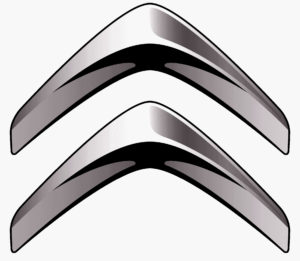The Champs-Élysées – not only one of the best known addresses in one of the world’s best known cities, but a name that carries huge significance – The Elysian Fields was the final resting place of the souls of the heroic and virtuous in Greek mythology, and the basis for Dante’s first circle of Hell – limbo, for virtuous heathens.
 The wide avenue that stretches from the Arc de Triomphe, past the Grand Palais to the Place de la Concorde and the Jardin des Tuileries has seen Citroën’s most prestigious showroom occupying number 42, through several incarnations since 1927.
The wide avenue that stretches from the Arc de Triomphe, past the Grand Palais to the Place de la Concorde and the Jardin des Tuileries has seen Citroën’s most prestigious showroom occupying number 42, through several incarnations since 1927.
1927 – 1932
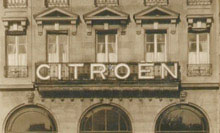 Described as having ‘Gothic arches, whose curves soften the severe vertical lines‘, the ‘soft light’ of the ‘showcase’ left nobody in any doubt that this was indeed the flagship of André Citroën’s empire. Few photos of the building seem to survive, unfortunately.
Described as having ‘Gothic arches, whose curves soften the severe vertical lines‘, the ‘soft light’ of the ‘showcase’ left nobody in any doubt that this was indeed the flagship of André Citroën’s empire. Few photos of the building seem to survive, unfortunately.
1932 – 1984
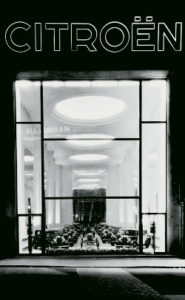 During August 1932, Andre Citroën decided that the building needed replacing. Oh, and it had to be open by the start of October. The same year. And they managed it… The frontage of the building symbolised avant-garde industrial design, with an immense plate-glass rectangular window being absolutely state-of-the-art and 1.75m tall illuminated CITROËN lettering above. The building survived the war, and served the company well through from the pre-Michelin RWD era until well into the PSA era.
During August 1932, Andre Citroën decided that the building needed replacing. Oh, and it had to be open by the start of October. The same year. And they managed it… The frontage of the building symbolised avant-garde industrial design, with an immense plate-glass rectangular window being absolutely state-of-the-art and 1.75m tall illuminated CITROËN lettering above. The building survived the war, and served the company well through from the pre-Michelin RWD era until well into the PSA era.
1984 – 2004
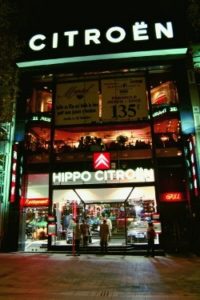 No longer primarily a car showroom, Hippo Citroën was a joint venture between Citroën and the Flo Brasserie chain. A 220-seat restaurant, it was intended to “promote new forms of contact“, which it did for around 2,800 people per day on average.
No longer primarily a car showroom, Hippo Citroën was a joint venture between Citroën and the Flo Brasserie chain. A 220-seat restaurant, it was intended to “promote new forms of contact“, which it did for around 2,800 people per day on average.
In 2001, an international architectural competition was launched. The replacement for Hippo Citroën was to be a Citroën showroom again, but more than that – it was to be “…a prestigious showcase, an opportunity for the public to discover or rediscover the past, present and future of Citroën, and thus to highlight the brand’s modern character and creativity in terms of innovation”
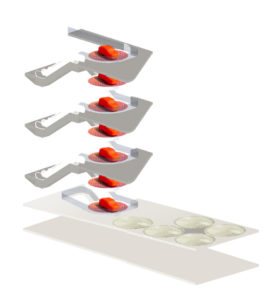 The unanimous winner of the competition was a relatively young and unknown Parisian architect, Manuelle Gautrand, with a proposal that was described as being inspired by Origami. A complex and technically advanced combination of a steel and three-dimensional glass lattice structure, the glasswork stands completely independently from the rest of the building, able to move up to 60mm to compensate for temperature variations and other movements. The main glass facade is composed of nineteen pyramids, standing between 500mm and 700mm from the main frontage, above a pair of large glass chevrons. Each glass panel is a different size and shape to every other panel, and all are made of a unique material with a gentle red tint by day, but provides a gentle glow when illuminated at night.
The unanimous winner of the competition was a relatively young and unknown Parisian architect, Manuelle Gautrand, with a proposal that was described as being inspired by Origami. A complex and technically advanced combination of a steel and three-dimensional glass lattice structure, the glasswork stands completely independently from the rest of the building, able to move up to 60mm to compensate for temperature variations and other movements. The main glass facade is composed of nineteen pyramids, standing between 500mm and 700mm from the main frontage, above a pair of large glass chevrons. Each glass panel is a different size and shape to every other panel, and all are made of a unique material with a gentle red tint by day, but provides a gentle glow when illuminated at night.
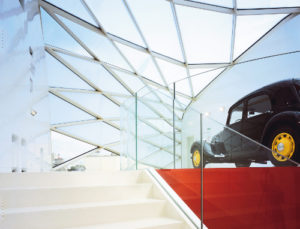 Once Hippo Citroën was closed in early 2004, demolition could begin. Construction of the new building started in early 2005, with the defining glass taking only five months to assemble. before opening in September 2007.
Once Hippo Citroën was closed in early 2004, demolition could begin. Construction of the new building started in early 2005, with the defining glass taking only five months to assemble. before opening in September 2007.
On entering the building, the main atrium contains a central mast of seven turntables, each containing a car – but with no visible means of loading the car onto the turntable.
Displays are changed regularly, according to seasonal themes, with new cars supplemented by classic Citroëns, prototypes and other exhibits from the Conservatoire.


